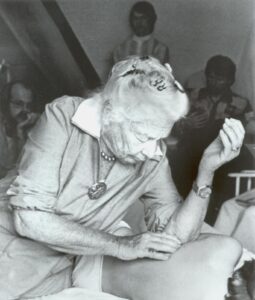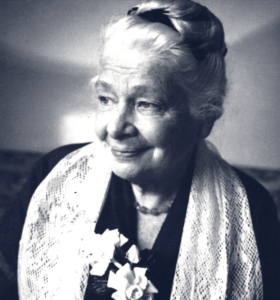
Ida Rolf’s Discoveries
Ida Rolf earned a Ph.D. in biochemistry from Columbia University in 1916. Somewhere in her scientific research, she made a fundamental discovery about the body: the same network of connective tissue which contains and links the muscle system when it’s healthy can be used to reshape it when it’s been pulled out of proper order. Each muscle (and each muscle fiber) is enveloped in a connective tissue called fascia. Toward the end of each muscle, this fascia thickens into straps we call tendons or ligaments, which work to bind muscle to muscle and muscle to bone. In fact, this strange stuff we term connective tissue might better be called prima materia, the basic stuff of the body. Part of it evolves into bone, and the muscles actually develop as tissue tendrils growing out through the fascial network in the embryo.

Dr. Rolf’s discovery of the importance of the fascial system revolutionized thinking about the body. Instead of muscles, her followers emphasize their covering, much as if, when looking at an orange, one emphasized the rind rather than the meat. The enwrapping fascia supports the muscles and holds muscle and bone combinations in place. But it has one troublesome property: it can support whatever patterns of movement and posture the body adopts. The fascia can aid normal balanced posture. Or, when muscles are overloaded by the constant strain of off-balance movement, these connective tissues may take over some of the load by shortening and giving up their elasticity. In this way the body actually changes shape to reflect how it’s being used. Fortunately, the fascia can be restored to health by returning muscles and bones to their proper alignments and inducing proper movement.
Dr. Rolf’s discovery of the importance of the fascia was based upon another insight. She recognized that gravity is the basic shaper of the body. We have to balance our bodies, somehow, against the pull of gravity. From birth to death, gravity is always working on us. Because it is, deviations in the muscle-bone system are never merely local. Gravity’s influence spreads them throughout the body. If the natural balance of the body is disturbed – if it doesn’t follow the best geometry of the skeleton – then the whole body will gradually change form to adapt to the deviation. For example, a child falls from a bicycle and injures a knee. To avoid pain, he or she tightens the muscles around that knee. Since the body must work against the tug of gravity, the entire muscle and fascia system gradually shifts to compensate for the first change. Movement through the pelvis is influenced, as is the pattern of breathing and the set of the head. Because muscles alone cannot carry the additional tension, the fasciae shorten to support the new movement, and, in time, the shape and function of the whole body alters with them.
The human body is like a house. It’s structured so that each part has its proper place, and each piece interlocks to balance the load of the others. As in the well-built house whose every post and beam is in place, the well-used (more than well-built) body functions efficiently. Because gravity pulls down on everything, out-of-place body parts – beams out of alignment and unsupported by a post – are pulled into painfully unnatural positions. What the Rolfer seeks is a return of the construction to its original blueprint specifications. This is often compared to, first, grabbing the client by the hair and lifting him or her straight up until he or she is hanging in a perfectly vertical position and, then, setting the client going again. Putting one out-of-whack piece back into place is usually not enough. Everything should be right before a house can stand or a body can work smoothly. This kind of arrangement, in turn, produces what Dr. Rolf called “the gospel of Rolfing: when the body is working properly, the force of gravity can flow through it. Then, spontaneously, the body heals itself.”

Dr. Rolf’s view of the role of the fascia in posture led to still another major discovery. It might be called the theory of body geometry.
When an elbow, knee or any other joint is properly balanced, the individual experiences an internal sense of rightness. The body senses that it is aligned along the true planes of movement. The hinges of the legs (hips, knees, ankles, even toes) all work within a single plane. The paths of the legs have parallel courses. The head and spine feel a clear sense of “up.” The elbows move naturally through their angle in a smooth course. Compared with this new organization, the previous functioning of the body appears random, even chaotic. In contrast, the new geometry, this new orientation in space, feels much more secure.